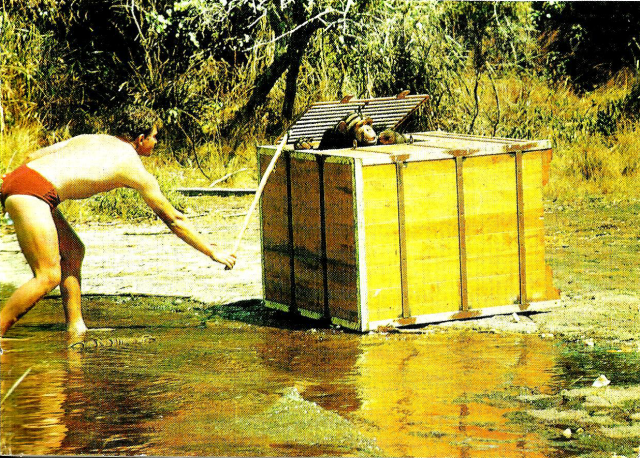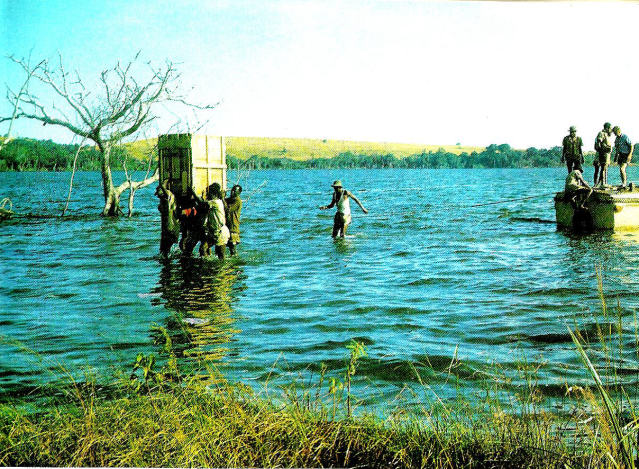Blog
December 27, 2013
How the chimpanzees arrived on Rubondo
By Mercedes Bailey, Rubondo Project Manager at Asilia Africa
The chimpanzees are certainly the most famous residents of Rubondo and many of our guests ask how they arrived on the island in the first place.
Establishing Rubondo as a haven for endangered species was the passion project of Professor Bernhard Grzimek of the Frankfurt Zoological Society. Over a four year period (1966-1969) he released 16 chimpanzees rescued from European zoos in four cohorts onto the island. The following extracts from his book ‘Among Animals of Africa’ explain that this was by no means an easy task!
“We chose a fairly level spot on the shores of Rubondo to unload the crates containing the chimpanzees. Although they had to be manhandled ashore, this gave us a chance to take refuge in the water after opening them. I must have caught bilharzia on this occasion. Some of the adult zoo chimpanzees were anything but harmless. One of them had already put a keeper in hospital. Another particularly spiteful male caused considerable mischief on Rubondo 18 months later. Sinclair Dunnet is here (photo above) seen opening a travelling crate with great care. He could retreat into the water at a moment’s notice because anthropoid apes are non-swimmers”.
The animals had no rehabilitation or pre-release training but after one year on Rubondo they were able to find and eat wild foods and construct nests for sleeping.
Grzimek continues:
“The full grown chimpanzees released on Rubondo quickly became acclimatized and have already multiplied. The island is very suitable for stocking with rare species of wildlife because no large predators are yet to be found there. According to recent research by Dr. Adrian Korllandt, chimpanzees deliberately strip branches of leaves and use them as weapons.”
This was the first ever attempt to rehabilitate captive chimpanzees. They have now reverted to an unhabituated state characteristic of wild chimpanzees and remain secretive. From 16 founders the population has now grown to around 35 individuals.
In addition to chimpanzees, seven other species were introduced to the island: Roan antelope and rhinoceros, Suni antelope, elephant, giraffe and black-and-white Colobus monkeys.
Grzimek explains;
“135 square mile of island at the southern end of mighty Lake Victoria have been cleared of human inhabitants and placed under a strict conservation order. In 1966, apart from gueraza monkeys and roan antelopes, we stocked the island with 10 chimpanzees from European zoos. They became well acclimatized and have since produced young’’.
Today we still have much to learn about the chimps, and other inhabitants of the island, and we fell honoured to be part of ensuring Grzimek’s vision of Rubondo as a safe haven is continued.
All photos used © Professor Bernhard Grzimek, from the book ‘Among Animals of Africa’
Read more about Bernhard Grzimek >
![]()










































Add comment
By Mercedes Bailey, Rubondo Project Manager at Asilia Africa
The chimpanzees are certainly the most famous residents of Rubondo and many of our guests ask how they arrived on the island in the first place.
Establishing Rubondo as a haven for endangered species was the passion project of Professor Bernhard Grzimek of the Frankfurt Zoological Society. Over a four year period (1966-1969) he released 16 chimpanzees rescued from European zoos in four cohorts onto the island. The following extracts from his book ‘Among Animals of Africa’ explain that this was by no means an easy task!
“We chose a fairly level spot on the shores of Rubondo to unload the crates containing the chimpanzees. Although they had to be manhandled ashore, this gave us a chance to take refuge in the water after opening them. I must have caught bilharzia on this occasion. Some of the adult zoo chimpanzees were anything but harmless. One of them had already put a keeper in hospital. Another particularly spiteful male caused considerable mischief on Rubondo 18 months later. Sinclair Dunnet is here (photo above) seen opening a travelling crate with great care. He could retreat into the water at a moment’s notice because anthropoid apes are non-swimmers”.
The animals had no rehabilitation or pre-release training but after one year on Rubondo they were able to find and eat wild foods and construct nests for sleeping.
Grzimek continues:
“The full grown chimpanzees released on Rubondo quickly became acclimatized and have already multiplied. The island is very suitable for stocking with rare species of wildlife because no large predators are yet to be found there. According to recent research by Dr. Adrian Korllandt, chimpanzees deliberately strip branches of leaves and use them as weapons.”
This was the first ever attempt to rehabilitate captive chimpanzees. They have now reverted to an unhabituated state characteristic of wild chimpanzees and remain secretive. From 16 founders the population has now grown to around 35 individuals.
In addition to chimpanzees, seven other species were introduced to the island: Roan antelope and rhinoceros, Suni antelope, elephant, giraffe and black-and-white Colobus monkeys.
Grzimek explains;
“135 square mile of island at the southern end of mighty Lake Victoria have been cleared of human inhabitants and placed under a strict conservation order. In 1966, apart from gueraza monkeys and roan antelopes, we stocked the island with 10 chimpanzees from European zoos. They became well acclimatized and have since produced young’’.
Today we still have much to learn about the chimps, and other inhabitants of the island, and we fell honoured to be part of ensuring Grzimek’s vision of Rubondo as a safe haven is continued.
All photos used © Professor Bernhard Grzimek, from the book ‘Among Animals of Africa’
Read more about Bernhard Grzimek >